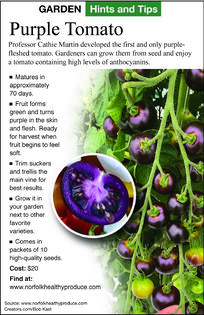The Greener View: Purple Tomatoes
Home gardeners can finally grow their own genetically engineered vegetable crop. Before I tell you what it is, we need to define the terms. "GMO" is a widely misused term. It stands for genetically modified organism. In the United States, this term has no legal definition. Many people think they are against anything that is genetically modified, especially foods. They don't understand that they are genetically modified (unless they are a clone of someone else).
As a general rule, we love genetically modified organisms. We want our pets to be healthier than their parents. We want our flowers to be prettier and have better disease resistance. We want our food crops to produce more. All of this genetically modified improvement has been done for thousands of generations. It is just plain old breeding and crossbreeding.
Next, we have genetically engineered organisms (GEO). In the past few decades, we have been able to catch up in the laboratory what nature has been able to do for a long time. A few pieces of DNA from one organism are transferred to another organism. Bacteria and viruses occasionally randomly do this in nature, but now we can be more particular and decide which genes we want to transfer from one type of organism to another.
A couple of years ago, the U.S. government decided to call genetically engineered foods bioengineered foods (BEO). Unfortunately, according to the USDA, all GEO and BEO plants and animals are also under the wider GMO status. Sure, all GE and BE organisms are genetically modified, but not with the old-fashioned crossbreeding, and that can make some people worried. When you can't define what a GMO is, you will run into problems talking to people about innovations in genetics.
That brings us to the purple tomato. It really is a dark purple inside and out. The color comes from the pigment anthocyanin which gives blueberries and eggplant their colors. While most domestic tomato plants produce some anthocyanin in their leaves, they don't produce much in their fruit. Natural crossbreeding with other species of tomatoes has helped increase the anthocyanin levels, but the tomatoes were not that great tasting.
Cathy Martin spent the past 20 years working to take the DNA from edible purple snapdragon flowers and move it into tomatoes. She finally succeeded and we now have purple tomatoes that have a much higher antioxidant level than before. It is an indeterminate cherry tomato that can be grown with the same gardening methods used for other indeterminate varieties. You can order seeds at www.norfolkhealthyproduce.com.
GE and BE foods are common on the grocery store shelf. Most of these engineered foods contain canola oil, corn, soybeans, sugar beets and sugarcane. You can find many breakfast cereals with GE labels. A few specialty foods are becoming available that are GE, such as apples with the word Arctic added to the name as in Arctic Granny Smith. Pink Pineapples from Del Monte have more carotenoids that give them the pink color. The USDA considers all Papaya sold in the U.S. to be from BE plants.
Although GE and BE foods have become more common, we have not been able to grow them in our gardens. All seed packets that have been labeled non-GMO have been lying. All garden seeds have always been derived from crossbreeding in the past, so they have always been genetically modified. We now have one garden seed available that is genetically engineered to create a tomato that has more antioxidants than other varieties of tomatoes.
========
Email questions to Jeff Rugg at info@greenerview.com. To find out more about Jeff Rugg and read features by other Creators Syndicate writers and cartoonists, visit the Creators Syndicate website at www.creators.com.
Copyright 2024 Jeff Rugg. Distributed By Creators.







